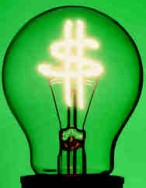
Make money, save planet Show me the green We are always being told how to save money and save the planet – but here’s how to go a step further. With the right investments you can actually make money whil helping save the planet. As U.S. policymakers begin to consider the idea of building a “Smart Grid,” (where your fridge talks to the power company and will switch off for a few hours at peak demand) , companies already in that business stand to benefit from federal grants and growing demand. The idea of a smart grid may never work because the cost of implementing it could outweigh the savings made, but some companies will get rich trying. Comverge Inc. (COMV) and EnerNOC Inc. (ENOC) are two good examples (No off-grid staff have any pecuniary interest in either company).
They install remote-control devices on thermostats and other electrical appliances that turn them down, or shut them off, during times of peak electricity demand, when power prices spike. Neither company is profitable yet (EnerNOC says it’ll be profitable next year) and their stocks have taken a beating amid the economic downturn and meltdown in energy stocks. Nevertheless, the practice called demand response, with its ability to cut energy use on a moment’s notice, is widely seen as a critical piece in the modernization of the U.S. electrical grid. The gadgets may also be of use in off-grid situations – turning down the fridge or the cooker when they reach a certain temperature, for example.
Comverge is listed on the Wilderhill Clean Energy Index and EnerNOC is on the Nasdaq Clean Edge U.S. Index, both of which are dominated by renewable energy companies.
Boston-based EnerNOC has 2,500 megawatts under management and is focused on commercial and industrial customers. Comverge of East Hanover, N.J., has more than 2,600 megawatts under management, with more focus on residential customers, although it also pursues business customers.
Shares of EnerNOC have recently been trading around $16, up from a 52-week low of $4.80 in November. Comverge is around $7, up from a low of $2.35 in November.
The Federal Energy Regulatory Commission earlier this month recommended that governments and utilities prioritize investment in demand response and other smart grid systems, such as energy storage and intersystem communication and security. Demand-response projects are amongst those eligible for a portion of the billions in federal funding set aside for energy efficiency and smart grid projects in the economic stimulus package that Congress passed in February.
Two proposals now in Congress would require utilities to shave 15% from their loads through efficiency measures, including demand response.
Analysts are generally positive about the outlook for Comverge and EnerNOC. Still, there is uncertainty about how ardently state regulators, which control the purse strings of many U.S. utilities, embrace demand response and conservation in general.
“Both stocks are concept stocks,” said Jesse Pichel, senior analyst at Piper Jaffray Cos. “The rubber hits the road when the companies start earning.”
Thus far, the total of several thousand megawatts of peak demand that the companies have contracted to take off the grid “is a small portion of potentially what’s out there,” said Piper Jaffray analyst Elaine Kwei, noting the reluctance of some regulators to contract for demand-response services.
As for their stock, Comverge and EnerNOC shares are likely to rise when the economy improves and energy demand grows again. Even though the companies don’t produce energy, their stocks tend to trade along with the shares of renewable energy companies, said Pavel Molchanov, an analyst with Raymond James in Houston.
“It’s a different concept, but investors see it as kind of the same thing,” said Molchanov. He has given a market perform rating to EnerNOC, which he said was “fairly defensive, given that they save people money.”
One Response
I don’t think much of some controlling my appliances. A better use of money would to design more energy efficient appliances. It would also behoove us to learn more of the old ways of preserving food. There a lot of ways to conserve than big brother doing it for us.